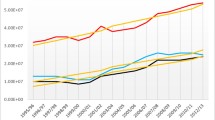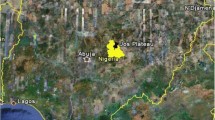Abstract
India has the largest cattle production in the world. Generally, Indian cattle are considered to be of poor quality, and it is suggested that most of these animals are useful only for beef but for their religious significance to the Hindu majority. Such generalization at the national level ignores the regional qualities of several superior indigenous breeds. Further, India together with some international agencies has launched the most comprehensive cattle development programs in the world. Known as the Key Village Scheme and Intensive Cattle Development Projects, their main objective is the spatial diffusion of superior quality breeds throughout the country. This study is the first attempt towards mapping andevaluating the problems and success of these programs at the district level in India.
Similar content being viewed by others
References
Mani, J.S.; Murty, V.V.R.: Estimates of Annual Meat Production by Using Random Sample Survey Technique. Agricultural Situation in India, 615–619 (1969). The annual beef production in India is estimated at 6,100 t.
Dutt, A.K.; Chatterjee, S.P.; Geib, M.Margaret: India in Maps. Kendall/Hunt Publishing Co., Dubuque, Iowa 1976, p. 42.
Randhawa, M.S.: Agriculture and Animal Husbandry in India. ICAR, New Delhi 1962, p. 259.
Directorate of Economics and Statistics: Indian Livestock Census 1972. Ministry of Agriculture and Irrigation, Government of India, Vol. I, Summary Tables, Delhi 1977, pp. 3–4. The bovine also includes a small number (44,000) of Yaks and Mithuns mostly confined to the Himalayan Mountain districts.
Simoons, F.J.: Questions in the Sacred Cow Controversy. Current Anthopology 20, 3, 471–472 (1979)
Government of Canada: Market for Canadian Exports: India. Industry, Trade and Commerce, Business Centre, Ministry of Supply and Services, Canada, 1977, Cat. No. C2–39/1977, p. 6.
See, for example, Harris, M.: Cows, Pigs, Wars and Witches. Random (Vintage), New York 1974, pp. 11–32; also by the same author: The Cultural Ecology of India's Sacred Cattle. Current Anthropology 7, 1, 51–66 (1966); Simoons, F.J.: The Sacred Cow and the Constitution of India. Ecology of Food and Nutrition 2, 281–296 (1973)
Directorate of Economics and Statistics: Indian Livestock Census 1972. Ministry of Agriculture and Irrigation, Government of India, Vol. II, Detailed Tables (unpublished); Indian Livestock Census 1966, Vol. II, Detailed Tables, Part I and II, 1972, pp. 1319.
In Americas these are known as Brahmans — a local term applicable only to the particular type of Zebu which has been evolved in the Southern United States by amalgamating several Indian breeds. See Joshi, N.R.: Zebu Cattle of India and Pakistan. FAO — Agricultural Studies 10, p. 11, Rome (1953)
Randhawa, M.S.: Role of Domesticated Animals in Indian History. Science and Culture XII, 1, p. 11 (1946)
Higginbottom, S.: The Cattle Drain in India. Asia and the America 38, 8, p. 473 (1938)
Publication and Information Directorate: Wealth of India. Livestock, Raw Materials, Vol. VI, Supplement, CSIR, New Delhi 1970, p. 27.
Indian Council of Agricultural Research: An Album of Indian Agriculture and Animal Husbandry Research. New Delhi 1953, pp. 19–20; Randhawa, M.S.: op. cit., ref. 3, pp. 262–277; Publication and Information Directorate, op. cit., ref. 12, 6–17; Dasgupta, S.C.: The Cow in India. Vol. I, Breeding — Dairy Industries, Khadi Pratisthan, Calcutta 1945, pp. 114–163; and the Indian Council of Agricultural Research: A Survey of Important Breeds and Types of Cattle in India. Bulletin No. 17, Delhi 1952, pp. 38 + LXXI, Plates.
Randhawa, op. cit., ref. 10, p. 10; and Singh, Jasbir: An Agricultural Atlas of India: A Geographical Analysis. Kurukshetra, India 1974–75, p. 282.
Publication and Information Directorate, op. cit., ref. 12, p. 19.
Hoffpauir, R.: The Indian Milk Buffalo: A Paradox of High Performance and Low Reputation. Asian Profile 5, 111–134 (1977); see also ref. no. 12, p. 19.
Mamoria, C.B.: Agricultural Problems of India. Kitab Mahal, India, IX ed., 1979, p. 348.
Gopalan, C.; Balasubramanian, S.C.; Rama Sastri, B.V.; Rao, K. Visweswara: Diet Atlas of India. National Institute of Nutrition, Hyderabad, India 1971, p. 132.
National Dairy Development Board of India: Dairying in India. XIX International Dairy Congress, India 1974, p. 3.
Planning Commission, Government of India: Third Five Year Plan, New Delhi, India (No publication date), p. 345.
Kaushal, B.S.: Scheme for Intensive Cattle Development. Report prepared for the Ministry of Agriculture, New Delhi 1963, 25 pp., mimeographed.
Ministry of Agriculture (Department of Agriculture): Revised List of Key Village Blocks, Urban Artificial Insemination Centres, Key Village Extension Centres and Centralized Semen Collection Stations other than those Merged with Intensive Cattle Development Projects. Livestock Development Tech. Sec., Govt. of India, New Delhi, December 1972, pp. 44, mimeographed.
Kaushal, op. cit., ref. 21, p. 2.
Planning Commission, Government of India: Fourth Five Year Plan 1969–74. New Delhi, India (No Publication date), p. 189.
Chakravarti, A.K.: Green Revolution in India. Annals Association of American Geographers 63, 319–330 (1973)
Government of India: Report of the National Commission on Agriculture 1976. Part VII, Animal Husbandry, Ministry of Agriculture and Irrigation, New Delhi 1976, p. 19.
Government of India: List of Intensive Cattle Development Projects (ICDP) Operating in Various States as on 31.3.1977. Ministry of Agriculture, New Delhi, mimeographed report, 4 pp.
Government of Rajasthan, Directorate, Animal Husbandry, Personal Letter: Ref. No. FV.29(40)PL(284)VII/76 990 Jaipur, Date 1.5.82.
Ref. 26, Appendix 28.6, p. 113.
Ref. 26, p. 31.
Makhijani, H.J.: Gaushalas and Pinjrapoles in India. Central Council of Gosamvardhana, New Delhi 1956. Quoted from Govt. of India, op. cit., ref. 26, pp. 36–37.
Ref. 26, pp. 87–88; and Directorate of Economics and Statistics, op. cit., Tab 1: Source.
Ref. 26, p. 24.
Ref. 26, pp. 53–62.
Krishnamurthy, S.: Cross-Breeding in Cattle for Enhancement of Milk Production — Suggested Guidelines in Field Application, The Present Infrastructure and its Development. National Conference on Cross-Breeding, National Dairy Development Board, Anand, India, 14–21 (April 27– 29, 1978)
(a) Nagarcenkar, R.; Rao, G.N.; Sriramamurty, A.: Breeding Programme for Cattle for Accelerating Milk Production Enhancement. National Conference on Cross-Breeding, op. cit., ref. 35, pp. 88–94; and (b) Nagarcenkar, R.: Optimum Level of Exotic Inheritence for Cross-Breeding. Symposium on Assessment of Cross-Breeding Programmes, Journal of Indian Society of Agricultural Statistics, 97–98 (1978)
Prem Narain: Strategy of Cross-Breeding in Livestock and Poultry. Symposium, op. cit., ref. 36 (b), pp. 94–97.
Krishnamurthy, Symposium, op. cit., ref. 36 (b), pp. 103–104.
Prem Narain, op. cit., ref. 36 (b), p. 96.
Chakravarti, A.K.: The Impact of the High-Yielding Varieties Program on Foodgrain Production in India. The Canadian Geographer XX, 199–223 (1976)
The release of Social Sciences and Humanities Research Council of Canada grant for conducting field work in India was subject to the permission by the Government of India. Since their Animal Husbandry Department did not approve the project (the evaluation of development programs), the field-work was carried out by the author with his own limited resources.
Bhatt, P.N.: Cross-Breeding of Dairy Cattle of Tropics for Improvement of Milk Production. Symposium, op. cit., ref. 36 (b), pp. 107–108.
The high temperature and solar radiation directly affect these animals through heat load. Also the high feeding level under high ambient temperatures increases metabolic heat production further adding the heat load factor. Thus a great amount of available energy is directed through metabolism towards maintaining the heat dissipating mechanism rather than for productive functions.
Acharya, R.M.: Consideration of Constraints of Physical Environment and Nutrition in Breeding Programme for Cattle. National Conference on Cross-Breeding, op. cit. ref. 35, pp. 77–87.
Chakravarti, A.K.: Foodgrain Sufficiency Patterns in India. The Geographical Review 60, 208–228 (1970)
For example, over 2 million or approximately 4 % of all the cows over 3 years are used for work only. Indian Livestock Census, op. cit., ref. 4. Tab 1, p. 3.
Directorate of Economics and Statistics: Indian Agriculture in Brief. Ministry of Agriculture and Irrigation, 17th edition, New Delhi 1979, p. 29.
Directorate of Economics and Statistics: Indian Agricultural Statistics 1967–68 to 1969–70. Vol. II, Detailed Tables, Ministry of Agriculture and Irrigation, Delhi 1978, 650 pp.
Ref. 4, pp. 3–4.
Jul, M.: Dairy Development in India — Part II. World Review of Animal, FAO Studies 25, 30–36 (1978)
Vishnay, T.N.: Cross-Breeding Programme in Cattle: Limitations in DPAP and Tribal Areas. National Conference on Cross-Breeding, op. cit., ref. 35, pp. 108–116.
Shukla, P.C.; Desai, M.C.: Feeding of Cross-Bred Cows in Gujarat State — Problems and need for Solutions. National Conference on Cross-Breeding, op. cit., ref. 35, pp. 215–221.
Reddy, Y.P.R.; Venkataraman, T.G.; Sampath, S.R.: Efficiency of Cross-Bred Cows in the Cost of Milk Production. Livestock Adviser 5–8 (1980)
Ref. 50, pp. 30–36. (US$ 1 = Rs. 8.50)
Bonde, H.S.; Deshpande, K.S.; Sewliker, A.L.: Problem of Low Milk Yield in Village Cross-Bred Cattle. National Conference on Cross-Breeding, op. cit., ref. 35, pp. 22–26.
Ref. 26, pp. 49–50 and 57.
Ref. 19, pp. 8–10.
Lamer, M.: Dairy Problems and Policies in India. Monthly Bulletin of Agricultural Economics and Statistics 10, 1–9 (1961)
Ref. 26, p. 4.
Ref. 26, pp. 5–6.
Singh, Daroga; Murty, V.V.R.; Goel, B.B.P.S.: Bovine Milk Production and its Per Capita Availability in Various Tracts of India. Agricultural Situation in India, 997–1001 (1967)
Krishnamurthy, S.: A Report on Progress Made in Cross-Breeding of Cattle for Increased Milk Production. Paper presented at the Conference of Animal Scientists and Livestock Breeders, Punjab Agricultural University, Ludhiana, April 3–4, 1975, mimeographed, 6 pp. and VIII Annexures.
National Dairy Development Board: Annual Report 1980-81. Anand, India, March 31, 1981, 44 pp.
Singh, Surendar: Operation Flood II: Some Constraints and Limitations. Economic and Political Weekly XIV, 42 and 43, 1765–1774 (Oct. 1979)
Bhote, R.A., Jayaraman, S.: Trends in Milk Production During 1951-61. Agricultural Situation in India, 664–673 (1967)
Singh, Surendar; Sharma, K.N.: Trends in Breedable Bovine Population and Milk Production. Agricultural Situation in India, 535–539 (1979)
Ref. 47, Ninth Edition, 1968, pp. 37–38.
Verma, O.S.: Dairy Development Through Integrated Dairy Farms. National Dairy Development Board, Conference, op. cit., ref. 35, pp. 275–279.
Ref. 19, p. 18.
Jakhade, V.M.; Shivamaggi, H.B.: Inter-District Comparison of Agricultural Development and Spread of Banking Facilities in the Rural Areas. Reserve Bank of India, Division of Rural Economics, Economics Department, Mimeograph Report + Tables, Bombay 1969.
Author information
Authors and Affiliations
Additional information
Grateful acknowledgement is made to the Social Sciences and Humanities Research Council of Canada for supporting the postfield work part of this study. The author also wishes to thank Dr. A. G. Phipps for helping in computer programming, Keith Bigelow for cartographic work, Keith Bell and Sue Ann Hipkin for data processing and mapping, and Mrs. Dorothy Young for the typing.
Rights and permissions
About this article
Cite this article
Chakravarti, A.K. Cattle development problems and programs in India: A regional analysis. GeoJournal 10, 21–45 (1985). https://doi.org/10.1007/BF00174664
Issue Date:
DOI: https://doi.org/10.1007/BF00174664




